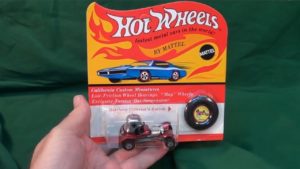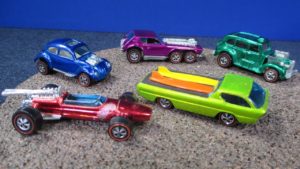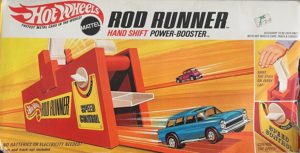
I hereby surmise that 1959 was the perfect year in which to be born. In addition to missing out on Vietnam, being too young, and having the computer age and the internet appearing at the right time for me to gain good employment in the fascinating fields, I was also very fortunate to have been eight years old when Hot Wheels were introduced. And an eight-year-old kid is the perfect demographic for Hot Wheels cars.
Kids have always loved miniatures. Our great-grandparents played with miniature horses and the like. When automobiles appeared, toymakers quickly followed suit with smaller versions for the kids.
By the 1960’s, Matchbox was the undisputed king of little cars. They had pushed past competitors like Corgi, Cigarbox (a little obvious there, brand name developers), and Tootsietoy to be the major supplier of toy autos to eager kids.
That all changed in 1968.
Mattel developed a new concept in small cars. Their prototype had an axle that was a flexible wire anchored towards its middle, allowing it to flex up and down, much like a real car’s suspension. Additionally, the wheels were very low-friction. That’s because Mattel used a special plastic called Delrin as a bushing between the axle and wheel. The wheels had a small ridge that was the actual point of contact on the track, reducing friction even further. The cars could travel a scale speed of 200 MPH.

And the cars didn’t just sit on the shelf, either. No, they were designed to run on flexible orange tracks with highly banked curves that could make figure eights. The cars could be propelled with a device called a Rod Runner (pictured) or a Supercharger.
Are you beginning to appreciate the brilliant marketing accomplishment that was Hot Wheels cars? This is stuff that every prepubescent boy in America immediately began relentlessly hammering on their parents to buy them. It was a new concept in miniature cars. Don’t just admire them, race them!
The original models released in 1968, according to Wikipedia, were Beatnik Bandit, Custom Barracuda, Custom Camaro, Custom Corvette, Custom Cougar, Custom Eldorado, Custom Firebird, Custom Fleetside, Custom Mustang, Custom T-Bird, Custom Volkswagen, Deora, Ford J-Car, Hot Heap, Python, and Silhouette. I had several of those. The Hot Heap looked like a dune buggy. The Fleetside was a pickup. The stockier models (e.g. Hot Heap and the Volkswagen) were dogs on the race track. The fastest were the lower, sleeker models like the Barracuda.
Each car came with a little metal clamp-on badge, too, making Hot Wheels even more irresistible.
The original cars cost around a dollar, as I recall. Surprisingly, that is still what they cost, although their quality is not what it once was.

They were covered with Spectraflame paint, a clear paint that shined like a new penny when applied to polished metal.
A kid would soon accumulate quite a few of these beauties, and that necessitated a carrying case. Mattel was more than happy to sell you one. They made a wheel-shaped model where your cars sat in a circle around the center in individual compartments. I had a rectangular case filled with long slots. You placed dividers in them to create individual compartments.
The cars were brilliant, but not perfect. For one, it was possible to bend those axles by over zealously pushing down on the top of the car. One you did that, it was over. I was never able to restore splayed axles.
That paint was easily chipped, too. A car went from gorgeous to ugly with a single noticeable chip. I even stripped all the paint off of some badly damaged ones, hoping they would look good with just the shiny metal. Alas, it quickly tarnished. You could also spray paint the cars, but the spray paint was even softer than the original Spectraflame.
Hot Wheels nearly put Matchbox out of business. They quickly realized that they needed to shift from making staid miniatures to outrageously tricked out hot rods. They survived, but were later absorbed by Mattel in 1996.
The brilliance of the concept can be seen by the fact that Hot Wheels continue to be a hot seller nearly forty years later.
And that creates another strange concept. If my grandfather was to buy me toys he played with as a kid, they would have been cast iron wheeled horses. But when my grandkids arrive, I’ll be able to buy them Hot Wheels cars (at the same price my parents paid!) very similar to the ones I had when I was eight years old.
I’m a ’57 boomer and I still have my original sweet 16 set from ’67, actually, plus the complete second set of, I think, 30?, from ’68 EXCEPT the Red Baron- never could find that original SOB. That is a minor miracle, as Mattell had spotty East Coast/Boston distribution plus deliberate underpacking of the most desirable new issue models back then. I have the repro reissue Baron as in your pic above. I hated the cheapo plastic/paper second edition badge pins. There was also a ‘limited edition’ ’68 chrome silver Boss Hoss Silver Special funny car dragster version Mustang which was only available to HW Collector’s Club members, & I had a hard time getting Mattell to actually send it. I never did get the Prudhomme/Garlits real life replica Snake & Mongoose lift up body funny cars OR ‘railer’ dragsters – you could only get those in track sets- good luck finding those.
Sorry for the late reply, but thanks for reminding me of the Boss Hoss! A friend had one, so I actually saw it up close and personal.